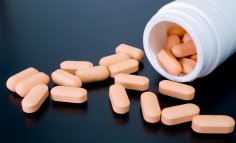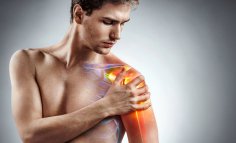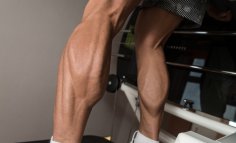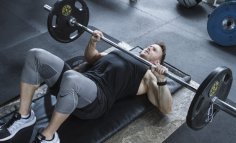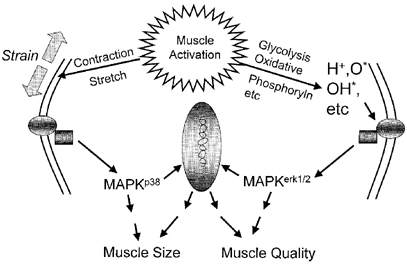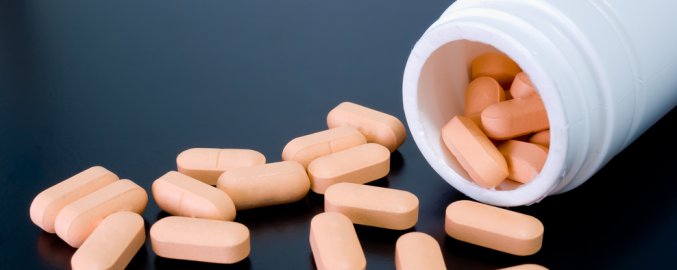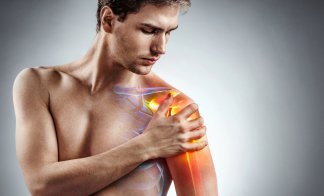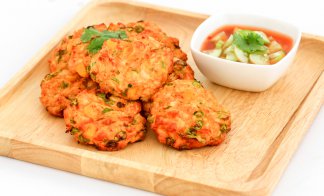The more advanced insights
First let me clarify that HST is based on physiologically sound principles not numbers. In short, they are:
• Progressive load
• Training volume
• Training frequency
• Conditioning (Repeated Bout effect)/Strategic Deconditioning
So we are dealing with 4 basic issues, Load, Volume, Frequency and Conditioning. Within these basic factors we have reps, sets, and rest. HST differs from previous training methods in many aspects, but particularly in how it incorporates knowledge of how the “cell” physiologically responds to the training stimulus in its methodology. Previous methods focus on effort (A.K.A Intensity), current voluntary strength, and psychological factors such as fatigue and variety.
• The number of Reps is determined by the minimum effective load (this changes over time based on Conditioning)
• The number of Sets is determined by the minimum effective volume (this changes over time according to current load and Conditioning.)
• The Rest between sets is determined by the amount of time required to regain sufficient strength to successfully achieve the minimum effective Volume.
• The Frequency (rest between workouts) is determined by the ability of the CNS to recover sufficiently to maintain baseline “health” indicators. It is also determined by the time course of genetic expression resultant from the previous workout.
• The interval of Strategic Deconditioning (SD) is determined by the time course of adaptation to the individuals maximum weight loads. In other words, SD is required to reset growth potential after plateauing. The duration of SD is determined by the level of conditioning attained during the training cycle.
Mechanical tension on the protein structures of the muscle cells is the primary stimulus for hypertrophy. This tension can elicit anabolic processes with or without damaged to the cell membrane. However, some damage to the cell membrane seems to be critical for the action of autocrine and paracrine growth factors (FGF, IGF-1, etc). Without the activity of these growth factors outside the cell there will be no increase in myonuclei, and thus no significant increase the the volume and/or number of the cells.
Some improvements in muscle cell function do occur even if the number of myonuclei remains the same. These won't lead to significant hypertrophy though. These improvements in muscle cell functional capacity involve ERK1/2. This is the pathway activated most when you get an intense burn and/or train to failure.
Muscle "activity" such as the typical repetition, and the metabolic byproducts and change in the internal millieu of the cell also "contribute" to hypertrophy, but only indirectly. Reps, and fatigue activate signaling proteins and transcription factors that increase protein synthesis. This increase in protein synthesis allows an increase in crucial enzymes, receptors (yes even androgen receptors), membrane and structural proteins. Remember that protein breakdown is also accelerated so the net effect is most often merely a maintenance of muscle protein levels. This is what goes on after each workout when plateauing after years of training.
As mentioned, without the activity of IGF-1 and FGF outside of the cell, satellite cells will not contribute significantly to hypertrophy. The process is dependant on microtrauma at some degree.
Studies have shown that the ability of a given amount of tension to elicit hypertrophy decreases over time in a given muscle. This is because the same adaptive process that leads to muscle growth, also leads to resistance to the stimulus of muscle growth. It has a lot to do with the principle of homeostasis, in other words, the body will always fight further change as it’s changing.
Studies have shown too much microtrauma is a bad thing. The rapid infiltration of immune factors (the primary cause of DOMS) actually causes significant breakdown of muscle proteins and the death of some cells.
Now, the ability of mechanical tension to cause microtrauma to the cell membrane is dependant on the condition of the extracellular matrix. If it is robust as a result of chronic strain, is will take an unaccustomed load to induce any trauma. Your ability to apply this load is dependant on your voluntary strength. Your body is able to protect your muscle cells from microtrauma even when using max loads. It isn't always able to protect tendons.
Anytime you do a set and it burns like crazy (painful burn) you are creating the same conditions of the occlusion studies. In other words, its not that the effects seen in this study don't happen without cutting off the blood supply, they do depending on the type of set. I would guess the vascular occlusion is increasing phosphorylation of MAPKerk1/2. erk1/2 appears to be more sensitive to acidosis, and oxygen radicals, both of which would be increased by lack of blood flow. Although less of a contributor than p38, erk1/2 does appear to contribute to hypertrophy.
Keep in mind that as a muscle contracts, it squeezes the blood out from the blood vessels around it. That is why your blood pressure goes up as large muscle groups contract (even clenching your fists actually raises blood pressure). This is also why pilots learn to contract their musculature to keep from passing out during high G-forces.
Contracting and relaxing a muscle acts like a blood-pump and plays a role in proper function of the cardiovascular system during exercise.
As was mentioned earlier, if you can increase the level of metabolic byproducts, decrease the pH and increase the level of oxygen radicals you will "help" to stimulate hypertrophy. However, this is not sufficient to elicit significant hypertrophy in the absence of progressive loading. In other words, flexing your muscles until they really burn won't really make you grow all that well. But combine it with progressive load and you will facilitate growth.
There is an excellent issue of The Journal of Pysiology that ties in the participation of mechanical strain vs Metabolic strain to muscle hypertrophy. In the issue you will get good explanations of mechanotransduction and how it relates to genetic expression leading to muscular hypertrophy. Its a must read for anybody into the science of contraction induced hypertrophy. J Phys Vol 535 No.1
Here is a model from the article showing in general terms how mechanical strain, and metabolic strain both contribute to hypertrophy, but to differing degrees. p38 leading more specifically to muscle size, while erk1/2 leads more towards improvements in muscle function or capacity. However, there is some overlap:
There are studies showing passive stretch eliciting a greater influence on erk1/2, and less so on p38.
Passive stretch puts the strain of the load on “structural” proteins (both collagenous and otherwise) and the cell membranes. When the fibers contract, it shifts the load to the contractile proteins (myosin, actin, z-discs, etc). This appears to be crucial for activation of p38, which of course leads to significant fiber hypertrophy.
I still like the loaded stretching. I do it where I can, shrugs, incline curls, chins, etc. But not all movements lend themselves to this kind of stretching.
Whether actual detrimental disruption of the structural proteins is required for growth or not is a good question. But what is not in question, is that mechanical (as opposed to metabolic) strain is required. The load must be transfered through mechanotransduction to the cell membrane and contractile structures.
I have used "muscle damage", "microtrauma" and "tissue strain" interchangeably...just easier to grasp I guess.
I would have to argue with the concept of the need for inflammation. With the release (autocrine & paracrine) of intracellular IGF-1 and subsequent activation of satellite cells, inflammation per say isn't required at all...
So, erk1/2 is phosphorylated in response to a drop in pH (lactic acid) and increase oxygen radicals. These are the two primary effects of metabolic activity. Thus, the cell will respond by increasing its metabolic and oxidative capacity in response to increases in erk1/2 and its associated transcriptional factors.
p38 on the other hand is not really effected by either pH or oxygen radicals. It is phosphorylated in respnse to strain on the contractile proteins in a muscle cell. This is why moderate "passive" stretch has little effect on muscle cells in-vitro.
In-vivo is a different situation using stretch. Animal models using stretch are not true stretch conditions because the animal will contract the muscles being stretched. The stretch is like holding onto a set of dumbells for days at a time. You will naturally contract against the pull of the weight by contracting the traps, even if it isn't hard enough to actually shrug the shoulders, you will hold a static contraction as long as you can. Make sense?
This is why in animal stretch studies you see significant hypertrophy associated with both erk1/2 and p38 activity.

